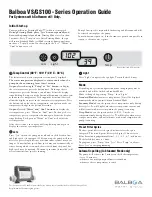
INSTALLATION
Safety
www.stiebel-eltron.com
WPL 10 AC | WPL 10 ACS |
7
INSTALLATION
7. Safety
7.1 General safety instructions
- Only a qualified contractor should carry out installation,
commissioning, maintenance and repair of the appliance.
- We guarantee trouble-free function and operational reliabil-
ity only if original accessories and spare parts intended for
the appliance are used.
7.2 Instructions, standards and regulations
Note
Observe all applicable national and regional regulations
and instructions.
8. Appliance description
The appliance protects the heating water lines against freezing up.
The integral frost protection circuit starts the circulation pump in
the heat pump circuit automatically at a condenser temperature
of 8 °C, and thereby ensures circulation in all water-carrying sec-
tions. If the temperature inside the buffer cylinder drops, the heat
pump starts automatically no later than when the temperature
falls below +5 °C.
8.1 Standard delivery
The following are delivered with the appliance:
- Wiring diagram
- Condensate drain hose
8.2 Accessories
8.2.1 Required accessories
- Heat pump manager with wall mounting casing, WPMW 3
8.2.2 Further accessories
- Wall mounting bracket WK 1
- T-support SK-WPL
- Mounting bracket MK 1
- Cylinder and hydraulic module HSBB 3
- Integral cylinder HSBC 200
- Hydraulic module HM (Trend)
- Pressure hoses DN 25
- Remote control for heating systems FEK
- Remote control for heating systems FE7
- Starting current limiter 25 A
- Safety temperature controller STB-FB
9. Preparations
!
D
00000
60
16
3
The appliance is designed for siting in front of a wall. Observe the
minimum clearances. If the appliance is installed in an open space
or on a roof, protect the air intake side. Do this by erecting a wall
to shield it against the wind.
9.1 Acoustic emissions
The appliance is louder on the air intake and air discharge sides
than on the two enclosed sides. Please therefore observe the in-
formation below.
For the sound power level, see chapter "Specification/Data table".
f
f
Ensure that the air intake direction is the same as the dom-
inant wind direction. Air should not be drawn in against the
wind.
f
f
Never direct the air intake or discharge towards noise sensi-
tive rooms of the house (e.g. bedrooms).
Lawn areas and shrubs help reduce the spread of noise.
Sound propagation can also be reduced by installing closely
spaced palisade fencing around the appliance. Observe the min-
imum clearances.
9.2 Minimum clearances
≥200
≥2000
≥500
≥1000
≥800
D
00000
22
15
3








































